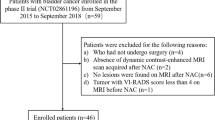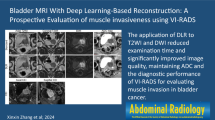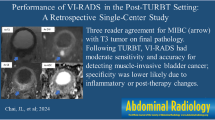Abstract
Objectives
To compare the diagnostic performance of a novel deep learning (DL) method based on T2-weighted imaging with the vesical imaging–reporting and data system (VI-RADS) in predicting muscle invasion in bladder cancer (MIBC).
Methods
A total of 215 tumours (129 for training and 31 for internal validation, centre 1; 55 for external validation, centre 2) were included. MIBC was confirmed by pathological examination. VI-RADS scores were provided by two groups of radiologists (readers 1 and readers 2) independently. A deep convolutional neural network was constructed in the training set, and validation was conducted on the internal and external validation sets. ROC analysis was performed to evaluate the performance for MIBC diagnosis.
Results
The AUCs of the DL model, readers 1, and readers 2 were as follows: in the internal validation set, 0.963, 0.843, and 0.852, respectively; in the external validation set, 0.861, 0.808, and 0.876, respectively. The accuracy of the DL model in the tumours scored VI-RADS 2 or 3 was higher than that of radiologists in the external validation set: for readers 1, 0.886 vs. 0.600, p = 0.006; for readers 2, 0.879 vs. 0.636, p = 0.021. The average processing time (38 s and 43 s in two validation sets) of the DL method was much shorter than the readers, with a reduction of over 100 s in both validation sets.
Conclusions
Compared to radiologists using VI-RADS, the DL method had a better diagnostic performance, shorter processing time, and robust generalisability, indicating good potential for diagnosing MIBC.
Key Points
• The DL model shows robust performance for MIBC diagnosis in both internal and external validation.
• The diagnostic performance of the DL model in the tumours scored VI-RADS 2 or 3 is better than that obtained by radiologists using VI-RADS.
• The DL method shows potential in the preoperative assessment of MIBC.





Similar content being viewed by others
Abbreviations
- AUC:
-
Area under the receiver operating characteristic curve
- BCa:
-
Bladder cancer
- CI:
-
Confidence interval
- DCE-MRI:
-
Dynamic contrast-enhanced MRI
- DL:
-
Deep learning
- DWI:
-
Diffusion-weighted imaging
- Grad-CAM:
-
Gradient-weighted class activation mapping
- MIBC:
-
Muscle-invasive bladder cancer
- MRI:
-
Magnetic resonance imaging
- NMIBC:
-
Non-muscle-invasive bladder cancer
- NPV:
-
Negative predictive value
- PPV:
-
Positive predictive value
- ROC:
-
Receiver operating characteristic
- T2WI:
-
T2-weighted imaging
- T-SNE:
-
T-distributed stochastic neighbour embedding
- TURBT:
-
Transurethral resection of the bladder tumour
- VI-RADS:
-
Vesical imaging–reporting and data system
- VOIs:
-
Volumes of interest
References
Bray F, Ferlay J, Soerjomataram I, Siegel RL, Torre LA, Jemal A (2018) Global cancer statistics 2018: GLOBOCAN estimates of incidence and mortality worldwide for 36 cancers in 185 countries. CA Cancer J Clin 68:394–424
Wu XR (2005) Urothelial tumorigenesis: a tale of divergent pathways. Nat Rev Cancer 5:713–725
Witjes JA, Bruins HM, Cathomas R et al (2021) European Association of Urology Guidelines on Muscle-invasive and Metastatic Bladder Cancer: Summary of the 2020 Guidelines. Eur Urol 79:82–104
Cookson MS, Herr HW, Zhang ZF, Soloway S, Sogani PC, Fair WR (1997) The treated natural history of high risk superficial bladder cancer: 15-year outcome. J Urol 158:62–67
Chang SS, Boorjian SA, Chou R et al (2016) Diagnosis and treatment of non-muscle invasive bladder cancer: AUA/SUO guideline. J Urol 196:1021–1029
Babjuk M, Bohle A, Burger M et al (2017) EAU guidelines on non-muscle-invasive urothelial carcinoma of the bladder: update 2016. Eur Urol 71:447–461
Josephson D, Pasin E, Stein JP (2014) Superficial bladder cancer: part 2. Management. Expert Rev Antican Ther 7:567–581
Sherif A, Jonsson MN, Wiklund NP (2007) Treatment of muscle-invasive bladder cancer. Expert Rev Anticancer Ther 7:1279–1283
Panebianco V, De Berardinis E, Barchetti G et al (2017) An evaluation of morphological and functional multi-parametric MRI sequences in classifying non-muscle and muscle invasive bladder cancer. Eur Radiol 27:3759–3766
Panebianco V, Narumi Y, Altun E et al (2018) Multiparametric magnetic resonance imaging for bladder cancer: development of VI-RADS (vesical imaging-reporting and data system). Eur Urol 74:294–306
Barchetti G, Simone G, Ceravolo I et al (2019) Multiparametric MRI of the bladder: inter-observer agreement and accuracy with the Vesical imaging-reporting and data system (VI-RADS) at a single reference center. Eur Radiol 29:5498–5506
Feng C, Wang Y, Dan G et al (2021) Evaluation of a fractional-order calculus diffusion model and bi-parametric VI-RADS for staging and grading bladder urothelial carcinoma. Eur Radiol 32:890–900
Akcay A, Yagci AB, Celen S, Ozlulerden Y, Turk NS, UFUK F (2021) VI-RADS score and tumor contact length in MRI: a potential method for the detection of muscle invasion in bladder cancer. Clin Imaging 77:25–36
Zheng Z, Xu F, Gu Z et al (2021) Combining multiparametric MRI radiomics signature with the vesical imaging-reporting and data system (VI-RADS) score to preoperatively differentiate muscle invasion of bladder cancer. Front Oncol. https://doi.org/10.3389/fonc.2021.619893
Zheng Z, Xu F, Gu Z et al (2021) Integrating multiparametric MRI radiomics features and the vesical imaging-reporting and data system (VI-RADS) for bladder cancer grading. Abdom Radiol 46:4311–4323
Wang X, Tu N, Sun F et al (2021) Detecting muscle invasion of bladder cancer using a proposed magnetic resonance imaging strategy. J Magn Reson Imaging 54:1212–1221
Kufukihara R, Kikuchi E, Shigeta K et al (2021) Diagnostic performance of the vesical imaging-reporting and data system for detecting muscle-invasive bladder cancer in real clinical settings: comparison with diagnostic cystoscopy. Urol Oncol 40:611–618
Wang H, Luo C, Zhang F et al (2019) Multiparametric MRI for bladder cancer: validation of VI-RADS for the detection of detrusor muscle invasion. Radiology 291:668–674
Metwally MI, Zeed NA, Hamed EM et al (2021) The validity, reliability, and reviewer acceptance of VI-RADS in assessing muscle invasion by bladder cancer: a multicenter prospective study. Eur Radiol 31:6949–6961
Wang H, Xu X, Zhang X et al (2020) Elaboration of a multisequence MRI-based radiomics signature for the preoperative prediction of the muscle-invasive status of bladder cancer: a double-center study. Eur Radiol 30:4816–4827
Zhang G, Wu Z, Zhang X et al (2022) CT-based radiomics to predict muscle invasion in bladder cancer. Eur Radiol 32:3260–3268
Zhang G, Wu Z, Xu L et al (2021) Deep learning on enhanced CT images can predict the muscular invasiveness of bladder cancer. Front Oncol 11:654–685
Yushkevich PA, Piven J, Hazlett HC et al (2006) User-guided 3D active contour segmentation of anatomical structures: significantly improved efficiency and reliability. Neuroimage 31:1116–1128
He K, Zhang X, Ren S, Sun J. (2016). Deep residual learning for image recognitionIEEE Conference on Computer Vision and Pattern Recognition, 2016, pp.770-778
Lin TY, Goyal P, Girshick R, He K, Dollar P (2020) Focal loss for dense object detection. IEEE Trans Pattern Anal Mach Intell 42:318–327
Kingma DP, Ba J (2014) Adam: a method for stochastic optimization. arXiv preprint arXiv:1412.6980. 10.48550/arXiv.1412.6980
Loshchilov I, Hutter F (2016) Sgdr: Stochastic gradient descent with warm restarts. arXiv preprint arXiv:1608.03983. 10.48550/arXiv.1608.03983
Selvaraju RR, Cogswell M, Das A, Vedantam R, Parikh D, Batra D (2017) (Grad-cam: Visual explanations from deep networks via gradient-based localization. Proceedings of the IEEE international conference on computer vision,, pp 618-626
Van der Maaten L, Hinton G (2008) Visualizing data using t-SNE. J Mach Learn Res 9:2579–2605
Ueno Y, Tamada T, Takeuchi M et al (2021) VI-RADS: multiinstitutional multireader diagnostic accuracy and interobserver agreement study. AJR Am J Roentgenol 216:1257–1266
Funding
This study has received funding by Dongguan Science and Technology of Social Development Program (20211800905212), Guangdong Basic and Applied Basic Research Foundation (2020A1515010571), and Shenzhen-Hong Kong Institute of Brain Science-Shenzhen Fundamental Research Institutions (2021SHIBS0003).
Author information
Authors and Affiliations
Corresponding authors
Ethics declarations
Guarantor
The scientific guarantor of this publication is Prof. Bingsheng Huang.
Conflict of interest
The authors of this manuscript declare no relationships with any companies whose products or services may be related to the subject matter of the article.
Statistics and biometry
One of the authors has significant statistical expertise.
Informed consent
Written informed consent was waived by the Institutional Review Board.
Ethical approval
Institutional Review Board approval was obtained.
Methodology
• retrospective
• diagnostic or prognostic study
• multi-centre study
Additional information
Publisher’s note
Springer Nature remains neutral with regard to jurisdictional claims in published maps and institutional affiliations.
Jianpeng Li and Kangyang Cao contributed to the work equally and should be regarded as co-first authors.
Supplementary Information
ESM 1
(DOCX 468 kb)
Rights and permissions
Springer Nature or its licensor (e.g. a society or other partner) holds exclusive rights to this article under a publishing agreement with the author(s) or other rightsholder(s); author self-archiving of the accepted manuscript version of this article is solely governed by the terms of such publishing agreement and applicable law.
About this article
Cite this article
Li, J., Cao, K., Lin, H. et al. Predicting muscle invasion in bladder cancer by deep learning analysis of MRI: comparison with vesical imaging–reporting and data system. Eur Radiol 33, 2699–2709 (2023). https://doi.org/10.1007/s00330-022-09272-7
Received:
Revised:
Accepted:
Published:
Issue Date:
DOI: https://doi.org/10.1007/s00330-022-09272-7




